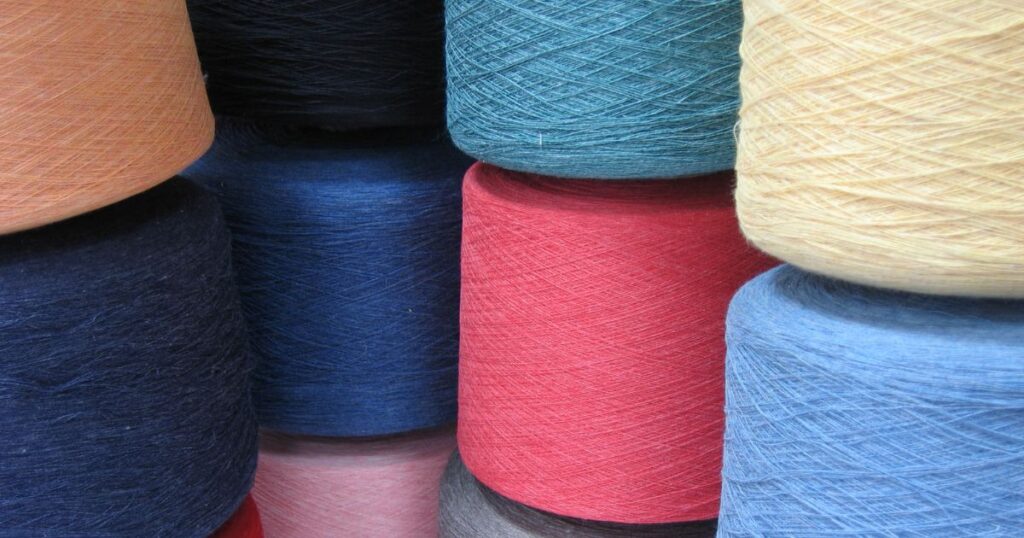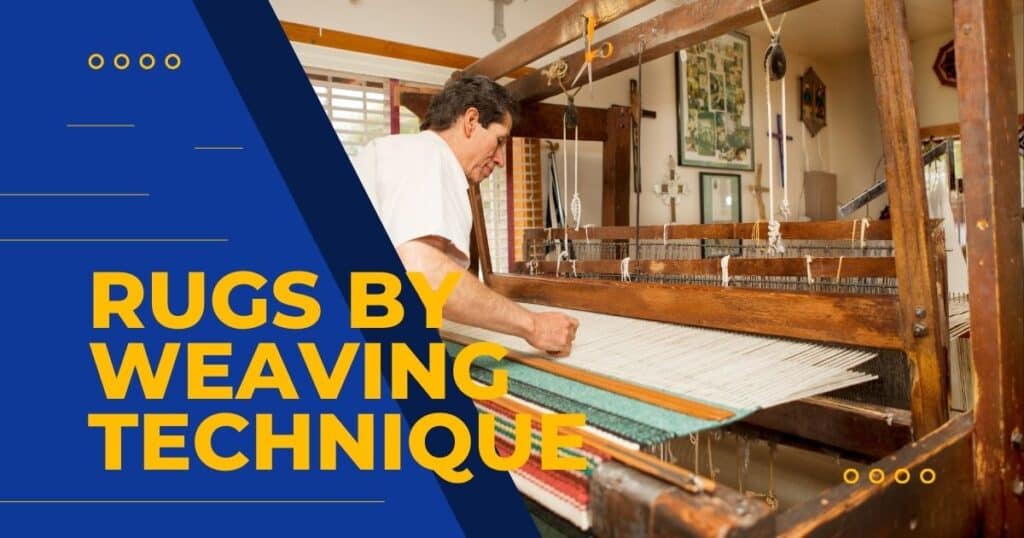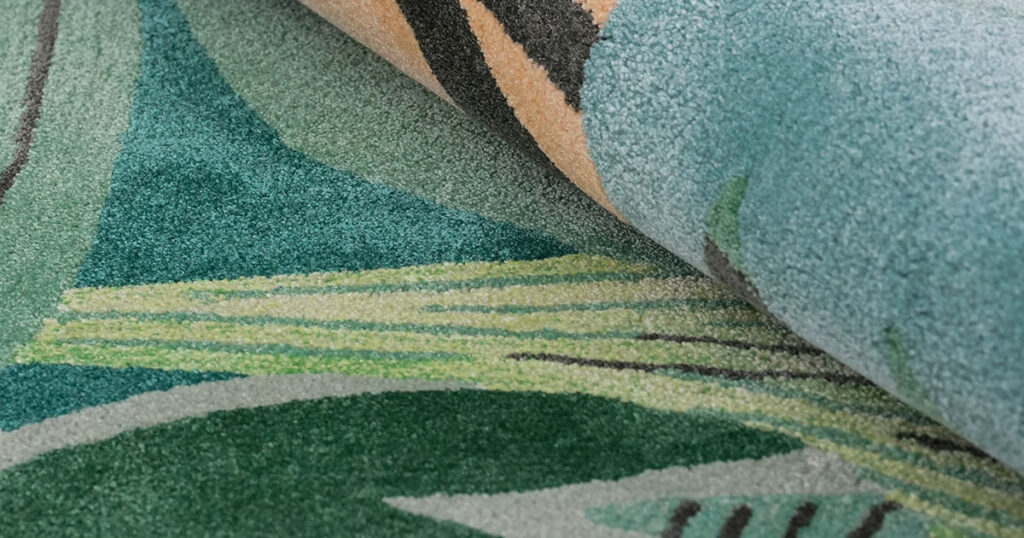This post breaks down key tufted rug specification terms.
It will help you communicate effectively with rug makers and suppliers.
It covers the concepts as listed below:
- Construction terms, differences between hand- and machine-tufting
- Common materials (wool, viscose, acrylic, polyester, etc.)
- Production processes
- Stages of ordering a custom rug
- Durability, maintenance, and commercial-grade specifications.
Let’s get started.
What Is a Tufted Rug?
A tufted rug is made by punching yarn through a backing material to create the pile surface. Unlike hand-knotted rugs, tufted rugs have no knots – the yarn tufts are secured to the backing with adhesive (usually latex) and a secondary backing cloth.
Tufting can be done by hand using a tufting gun or by machine on large tufting frames. This method is faster and more cost-effective than traditional weaving or knotting, making tufted rugs popular for both custom-made orders and mass-produced commercial carpets.
Construction Basics
Pile
The pile refers to the visible surface yarn of the rug – the fibers you walk on.
You can also take pile as the yarn of a tufted rug.
- The pile of a tufted rug has 2 types
- They are cut pile and loop pile
Pile Height
The pile height is the length of rug tufts from the base of the rug to the tip.
And pile height affects the rug’s look and feel.
- Usually, we measure it in fractions of an inch or millimeters.
- Low pile (short fibers) tends to be flat and durable.
- High pile (long fibers) creates a plush effect but can flatten in high-traffic areas.
For custom tufted rugs, you can require a rug to be made with only low piles, high piles or a combinations of both.
Usually, we combine at least 2 pile heights to create a better visual effect.
Cut Pile vs. Loop Pile
These terms describe the form of the pile yarns.
Cut pile means the loops have been cut, so the yarn strands stand upright with open ends, in order to create a softer, velvety surface.
Loop pile means the yarn remains in uncut loops, which creates a textured, knobby surface.
- For custom tufted rugs, you can combine cut vs. loop (or multiple pile heights) to add visual depth and define patterns.
Pile Density
Density refers to how closely we – tufted rug maker – do the tufts together and how much yarn is used in a given area of the rug.
- Higher density typically means better durability as the piles support each other.
- Low density may expose the backing cloth when you bend or roll the tufted rug.
Face Weight
The weight of pile yarn per unit area, often expressed in ounces per square yard.
- A higher face weight or density generally means a more durable and lush rug.
- But a very high pile height (like 45mm) with low density can have the same face weight as a low, dense pile (the latter will perform better under foot traffic0.
In commercial specifications, you can also see metrics like stitches per inch, tufting gauge (spacing of tufting needles), or total ounce weight.
They all relate to density and durability.
Backing Structure
Primary Backing
This is the foundation fabric through which the yarns are tufted.
The primary backing is often a sturdy canvas or polyester cloth stretched on a frame.
- The workers or machine punch the yarn through this backing.
- Create loops on the front and leaving tuft “tails” on the back.
- The primary backing (sometimes called a scrim) holds the pattern – often a design is printed or drawn on it as a guide for hand-tufting.
Latex Adhesive
We need to apply a coating of latex adhesive to the back of the primary backing after tufting to secure the tufts.
- This latex (a rubbery glue) locks the pile yarns in place so they won’t pull out.
- After applying the latex (and after dries), we apply a secondary backing.
Secondary Backing
The secondary backing is a layer of fabric (often cotton, canvas, or a synthetic mesh like action backing).
It covers the latex and adds strength and stability
- Generally speaking, when someone refers to a tufted rug’s backing, they usually mean this latex-and-cloth composite backing that covers the back of the rug.
Finishing Techniques
Shearing
After tufting and backing, we will need to shear tufted rugs to make the surface flat, smooth or obtain desired visual effects.
- Shearing means we use a blade or rotary cutter to pass over the rug’s surface.
- It will trim the pile to an even height and to remove any uneven yarn ends or fuzz.
Carving/Sculpting
Carving is a hand-finishing technique that workers use to create carved lines or textures in the pile.
- An artisan uses carving tools or scissors to trim and sculpt the pile at varying heights, outlining patterns or creating 3D effects (for example, to produce tufted moss rugs).
Edge Finishing
Tufted rugs (especially area rugs cut from broadloom) need their edges finished so they don’t fray.
- Binding: Applying a strip of fabric along the rug’s edges, sewn on to secure the edge, and sewn on to cover and secure the edge.
- Serging: Wrapping the edge with yarn in a continuous overlock stitch, to create a stitched finish that looks like a thick thread wrapping.
- Fringe: Purely decorative, but you can choose fringes to be sewn on to the ends to simulate the traditional look of hand knotted rugs.
Hand-Tufted vs. Machine-Tufted
Hand-Tufted Rugs
Hand-tufted rugs are made by artisans using hand-operated tufting guns.
The tufter shoots yarn through the cloth, section by section, to follow the design.
The backing cloth has the pattern drawn on it as a guide, and the artisan follows this to create the design.
Advantages:
- Allows for intricate, custom designs – including curves, detailed images, and color gradations – not to be limited by a weaving grid
- Enables changes in yarn types, colors, and pile heights
- Perfect for one-of-a-kind designs like company logos
- Often uses high-quality materials like wool or silk blends
Production notes:
- More labor-intensive but faster than hand-knotted rugs
- Can take weeks rather than months to complete
- Typically requires 6-8 weeks lead time after design approval
Machine-Tufted Rugs
We can also produce tufted rugs with computer controlled tufting machines and large tufting frames.
Machine-tufted rugs are excellent choices when you need good cost effectiveness for commercial installations.
Advantages:
- Highly efficient mass production, especially for repeating patterns
- Consistency and uniformity across multiple rugs
- Lower cost per unit, especially for large orders
- Shorter lead times for large-scale production
Limitations:
- Less flexibility in design complexity
- Often requires minimum order quantities
- Patterns may need to be repetitive or have color limitations
Materials and Fibers
Wool
Wool is the classic premium rug fiber, which is a natural fiber shorn from sheep.
Most of our customers prefer this yarn type for their customer tufted rugs.
- Overall, wool is an excellent all-around fiber for tufted rugs if budget permits.
- It gives a high-end look, long wear, and is suitable for both residential and many commercial applications (where a touch of luxury is desired).
There are multiple popular types of wool used for rug making.
They include: New Zealand wool, Indian wool, Himalayan wool, Merino wool, etc.
Acrylic
Acrylic is a synthetic fiber, originally developed as an economical substitute for wool (sometimes called “art wool”).
It has properties somewhat similar to wool’s appearance.
- Acrylic can look and feel reasonably similar to wool – it is often springy and has a warm, wool-like hand.
- It takes color well, so acrylic rugs often have vibrant colors that resist fading.
- The big drawback is that acrylic is less durable and resilient than wool.
Rayon (Viscose)
We also call it art silk (artificial silk).
It is a semi-synthetic fiber made from cellulose (wood pulp or bamboo).
And it is chemically processed to have a mulberry silk-like appearance.
- Viscose fiber is soft and shiny, giving rugs a lustrous, silky sheen.
- We use it for tufted rugs to add a silken accent or to mimic the look of real silk at a fraction of the cost.
- However, it does not wear well under heavy foot traffic – the yarn lacks resilience and can flatten or fuzz quickly.
Commercial Considerations
Maintenance Considerations
Shedding
Shedding means loose fibers come out of the pile and appear as fluff on the rug’s surface.
- This is especially common with woolen cut-pile rugs.
- These fibers have short ends that work their way out.
Sprouting
This term refers to individual yarn tufts that may stick up above the pile surface.
- In tufted rugs, you may occasionally see a loop or yarn piece not fully caught by latex or pulled slightly.
- Sprouting appears as a single strand longer than the rest, looking like a loose thread.
Pile Distortion
Some visual effects can occur in cut-pile carpets.
We call it shading, pooling, or pile reversal.
- Shading is when areas of the rug appear lighter or darker purely due to the direction the pile lays.
- Foot traffic can make some fibers lie in one direction which reflects light differently.
- This can look like watermarks or random dark/light patches – but actually not a stain or true wear, just a visual effect.
Maintenance Plan
Other Commercial Specifications
- Anti-Static Properties: Important for office environments with electronics
- Indoor Air Quality: Standards like CRI Green Label Plus for low VOC emissions
- Antimicrobial Treatments: To prevent mold/mildew in certain environments
Ordering Process
Design Briefing
Discuss size, shape, design, intended use, colors, patterns, and brand guidelines.
Quotation and Specifications
Review price, materials, construction details, lead time, and commercial standards needed.
Sampling (Strike-Off)
This is especially useful or important for custom-designed rugs.
After design confirmation, we manufacturers will create a sample for approval before making the full rug.
We often call this sample a strike-off.
- It might be a small piece of the rug (for example, a 2’ x 2’ / 50 x 50 cm section showing the pattern and colors)
- Or, a set of yarn pom samples and a digital print if a physical tufted sample is too large/expensive.
Revisions and Approval
Provide feedback on color accuracy, material feel, pattern scale, and special effects.
Full Production
The approved design goes into production, following the sample’s parameters.
Quality Check and Delivery
The manufacturer ensures dimensions, design, and quality meet standards before shipping.
Installation and Follow-Up
Consider maintenance guides and confirm warranties or maintenance contracts.
Conclusion
Understanding tufted rug terminology allows you to communicate effectively with suppliers and make informed decisions about your commercial rug purchases. From construction basics to material selection and commercial specifications, this knowledge ensures you select the right product for your specific needs, balancing aesthetics, durability, and budget.
Whether you’re outfitting a hotel lobby, commercial office, or retail space, the right tufted rug can enhance the environment while meeting practical requirements. By mastering this terminology, you’ll approach your next rug purchase with confidence.




